SPECIAL RELEASE
Oriental Mindoro Building Construction Statistics
June 2024
(Preliminary Results)
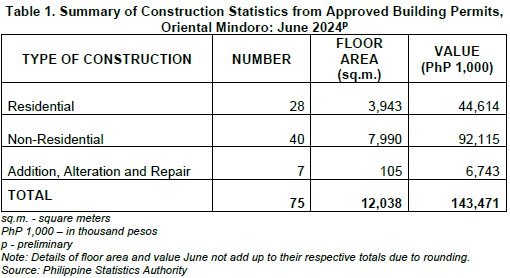
Non-Residential buildings had the highest number of constructions
In June 2024, the Province of Oriental Mindoro recorded a total of 75 constructions based on the approved building permits.
By type of construction, non-residential buildings reported the highest number of constructions at 40, accounting for 53.3 percent of the total number of constructions during the month. Majority of the non-residential constructions were commercial buildings with 33 (82.5 percent).
Meanwhile, residential building type constructions followed in terms of number of constructions at 28, constituting 37.3 percent of the total number of constructions.
Most of the residential constructions were single-type houses with 26 (92.9 percent).
Addition, and alteration and repair of existing structures had a total of 7 constructions, which contributed 9.33 percent to the total number of constructions in the province during the reference month.
Figure 1. Number of Constructions by Type, Oriental Mindoro: June 2024p
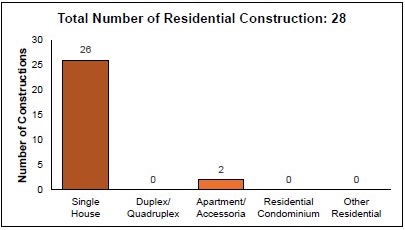
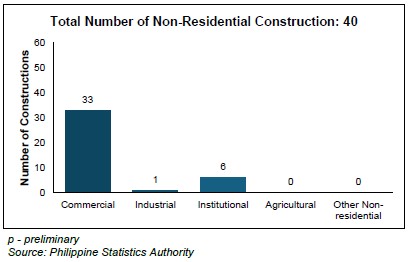
Non-Residential buildings recorded the highest value of constructions
In June 2024, the total value of constructions in Oriental Mindoro amounted to PhP 143.47 million.
Non-Residential building constructions valued at PhP 92.11 million, accounted for 64.2 percent of the total value of constructions during the period. Among non-residential constructions, commercial buildings registered the highest value of constructions at PhP 57.16 million (62.0 percent).
On the other hand, the construction value of residential buildings amounted to PhP 44.61 million, representing 31.1 percent of the total construction value in June 2024. Among residential constructions, single-type houses had the highest value of constructions at PhP 37.16 million (83.3 percent).
In June 2024, the value of constructions for addition, and alteration and repair to existing structures were recorded at PhP 0.55 million and PhP 6.19 million, respectively, both constituting 4.7 percent of the total construction value in the province.
Figure 2. Value of Constructions by Type, Oriental Mindoro: June 2024p
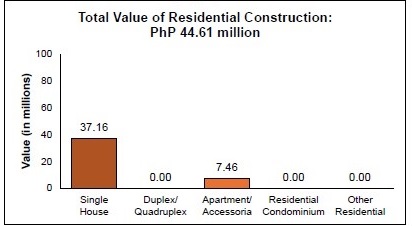
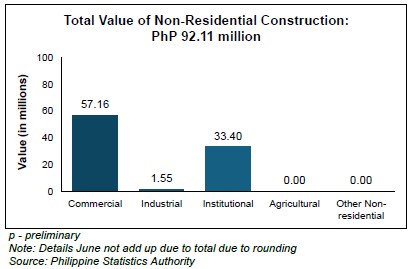
Non-residential constructions accounted for more than half of the total floor area of constructions
The total floor area of constructions for this month was recorded at 12,038 square meters. Non-residential constructions posted 7,990 square meters, accounting for 66.4 percent of the total floor area of constructions in this period.
Meanwhile, residential constructions recorded 3,943 square meters, representing 32.8 percent of the total floor area of constructions in the province in June 2024.
Figure 3. Floor Area of Constructions
by Type, Oriental Mindoro: June 2024p
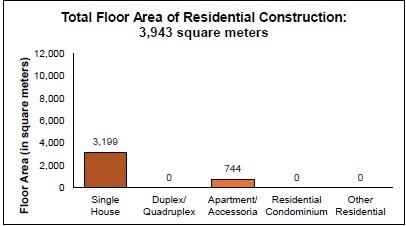
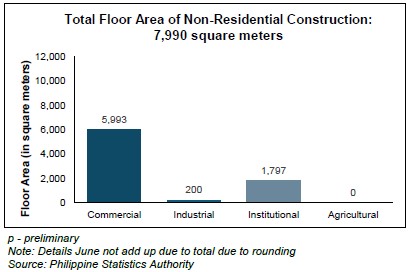
(SGD) CHARLYN ROMERO-CANTOS
(Chief Administrative Officer)
Officer-in-Charge
Oriental Mindoro Provincial Statistical Office
TECHNICAL NOTES
The Philippine Statistics Authority (PSA) stands as the primary statistical authority tasked with the collection, compilation, analysis, and dissemination of statistical information. Construction statistics play a pivotal role in understanding the pulse of economic development and urban growth within the Province of Oriental Mindoro. As a vital component of economic indicators, these statistics offer valuable insights into the trajectory of the construction sector, which serves as a cornerstone of infrastructure development and societal progress.
Construction statistics from approved building permits aim to provide monthly administrative-based data on building constructions at the municipality level nationwide. Statistics generated are the following:
1. number of units/buildings
2. floor area of the buildings
3. types of construction
4. value of construction
The statistics cover various aspects of construction, including new constructions, renovations, alterations, demolitions, and additions to existing structures.
DEFINITION OF TERMS
The definition of terms is adopted from the Revised and Updated IRR of the National Building Code.
Building permit is a written authorization granted by the LBO to an applicant allowing him to proceed with the construction of a specific project after plans, specifications, and other pertinent documents have been found to be in conformity with the National Building Code (PD 1096).
Building refers to any independent, free-standing structure comprised of one or more rooms or other spaces, covered by a roof and enclosed with external walls or dividing walls, which extend from the foundation to the roof.
Construction refers to all on-site work done from site preparation, excavation, foundation, assembly of all the components and installation of utilities, machineries, and equipment of buildings/structures.
Residential building is a building for which its major parts or more than half of its gross floor area is built for dwelling purposes. This type of building can be of the single type, duplex, apartment and/or accessoria, and residential condominium.
Single house is a complete structure intended for a single family or household, i.e., bungalow, 2-storey house, nipa hut, etc.
Duplex house is a structure intended for two households, with complete living facilities for each; it is a single structure divided into two dwelling units by a wall extending from the floor to the ceiling.
Apartment is a structure, usually of two storeys, made up of independent living quarters, with independent entrances from internal walls and courts.
Accesoria is a one or two-floor structure divided into several dwelling units, each dwelling unit having its own separate entrance from the outside.
Residential condominium is a structure, usually of several storeys, consisting of multiple dwelling units.
Other residential construction consists of school or company staff houses, living quarters for drivers and maids, and guardhouses.
Non-residential buildings include commercial, industrial, agricultural, and institutional buildings.
Commercial buildings refer to office buildings and all buildings which are intended for use primarily in wholesale, retail, and service trades; i.e., stores, hotels, restaurants, banks, disco houses, etc.
Industrial buildings are buildings used to house the production, assembly, and warehousing activities of industrial establishments; i.e., factories, plants, mills, repair shops, machine shops, printing press, storage plants, electric generating plants.
Institutional buildings are buildings which primarily engaged in providing educational instructions and hospital/health care; ports, airports and other government buildings; i.e., schools, museums, libraries, sanitaria, churches, hospitals.
Agricultural buildings are buildings used to house livestock, plants, and agricultural products such as barns, poultry houses, piggeries, stables, greenhouses, and grain mills.
Other non-building constructions include cemetery structures, street furniture, waiting sheds, communication towers, etc.
Addition refers to any new construction which increases the height or area of an existing building/structure.
Repair is a remedial work done on any damaged or deteriorated portion/s of a building/structure to restore its original condition.
Renovation is any physical change made on structures to increase their value and quality.
Alteration is a construction in a building/structure involving changes in the materials used, partitioning and location/size of openings, structural parts, existing utilities, and equipment but does not increase the overall area thereof.
Conversion is a change in the use or occupancy of structure or any portion thereof, which has different requirements.
Demolitions refer to the systematic dismantling or destruction of a building/structure, in whole or in part.
Street furniture are street structures consisting of monuments, waiting sheds, benches, plant boxes, lampposts, electric poles, and telephone poles.
Floor area of building refers to the sum of the area of each floor of the building measured to the outer surface of the outer walls including the area of lobbies, cellars, elevator shafts, and all communal spaces in multi-dwellings. Areas of balconies are excluded.
Total value of construction refers to the sum of the cost of building, electrical, mechanical, plumbing, and others. The value is derived from the approved building permit and represents the estimated value of the building or structure when completed.

